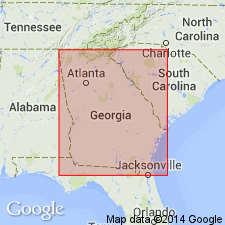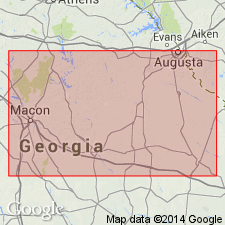
- Usage in publication:
-
- Roberta sandstone member
- Modifications:
-
- Named
- Dominant lithology:
-
- Sandstone
- AAPG geologic province:
-
- South Georgia sedimentary province
Summary:
Name Roberta sandstone member of Barnwell formation applied to the argillaceous red sands composing the typical Barnwell, that is above and outside the area of outcrop of the Irwinton and upper sand members. Thickness 15 to 40 ft. In extreme northeastern GA, beds occur higher in the section than the other members; in Crawford and possibly Peach Co., they occur unconformably upon uppermost Twiggs clay member. Member is also present in Glascock and Jefferson Cos. Age is late Eocene.
Source: GNU records (USGS DDS-6; Reston GNULEX).

- Usage in publication:
-
- Roberta
- Modifications:
-
- Not used
- AAPG geologic province:
-
- South Georgia sedimentary province
Summary:
Roberta sand of Connell (1958) is abandoned because it is inseparable from Irwinton Sand Member of Dry Branch Formation both in lithology and in stratigraphic position.
Source: GNU records (USGS DDS-6; Reston GNULEX).
For more information, please contact Nancy Stamm, Geologic Names Committee Secretary.
Asterisk (*) indicates published by U.S. Geological Survey authors.
"No current usage" (†) implies that a name has been abandoned or has fallen into disuse. Former usage and, if known, replacement name given in parentheses ( ).
Slash (/) indicates name conflicts with nomenclatural guidelines (CSN, 1933; ACSN, 1961, 1970; NACSN, 1983, 2005, 2021). May be explained within brackets ([ ]).

